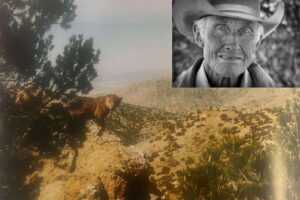ARIZONA—On April 11, the Arizona Game and Fish Commission rejected a formal petition from the Center for Biological Diversity and other environmental groups. The petition sought to ban the use of hunting dogs to harvest game in Arizona, citing the harassment of jaguars by hound hunting dogs as their top concern.
The Arizona Game and Fish Commission voted unanimously on April 11 to reject a petition seeking to ban recreational hound hunting of mammals, including mountain lions and black bears.
Here’s the scoop.
The petition, filed by the Center for Biological Diversity and co-signed by Wildlife for All, raised concerns about public safety, fair chase ethics, and the potential impacts on endangered species. The 2025- 34-page petition requested that the Commission amend Arizona Administrative Code R12-4-304 to prohibit the use of dogs in the pursuit and hunting of mammals.
Petitioners argued that using GPS-collared hounds allows hunters to track animals remotely. The petition states that using radio collars on hunting dogs violates the principles of fair chase ethics and increases the risk of conflicts with protected wildlife, including jaguars and ocelots.
In its formal response, the Arizona Game and Fish Department (AZGFD) recommended that the Commission deny the petition, citing a lack of scientific data and a failure to demonstrate a need for regulatory change.
“Allegations by the petitioners that hunting with dogs disrupts ecosystem balance, represents a public safety hazard, or threatens protected wildlife are unfounded and not supported by scientific literature,” AZGFD wrote in its April 2025 report.
AZGFD criticized the petition for relying on non-peer-reviewed sources, including blog posts, advocacy group content, and news articles, stating that such materials do not meet the standards for regulatory decision-making.
“Decision-makers must base their decisions on objective peer-reviewed science and reliable sources of consistently gathered information,” stated AZGFD.
Michael Colaianni Public Affairs & Media Relations Director with AZGFD, said, “After a lengthy presentation from the Arizona Game and Fish Department’s subject matter experts, the commission voted unanimously 5-0 to deny the petition that would have prohibited the use of dogs to hunt mountain lions, bears, and other wildlife. Allegations by the petitioners that hunting with dogs disrupts ecosystem balance, represents a public safety hazard, is a risk to nontarget and protected wildlife, and violates Arizona’s laws and regulations are unfounded and not supported by information in the petition or anywhere we could find in the scientific literature.”
The Mountain Daily Star conducted thorough research and found no scholarly articles on the harassment of jaguars by hounds or hunting dogs in the University of Arizona’s research digital library or the well-known database JSTOR. What we did find is a study that calculated the number of jaguars reported killed or photographed in Arizona by decade, from June 25, 1858, to November 29, 2016.
What we found:
Updates of Historic and Contemporary Records of Jaguars from Arizona. Journal of the Arizona-Nevada Academy of Science, 49(2), 65–91.
A previous petition aimed at reintroducing the jaguar into New Mexico and Arizona, specifically on tribal lands.
The Center for Biological Diversity petitioned the Secretary of the Interior and the U.S. Fish and Wildlife Service in 2022 to revise the designation of critical habitat for the endangered jaguar (Panthera onca) under authority of section 4 of the Endangered Species Act and, second, reintroduce the jaguar to the Gila National Forest in New Mexico as an experimental population under authority of section 10(j) of the Endangered Species Act.
The 2022 petition describes the White Mountain Apache Tribe exercises sovereignty over the Fort Apache Indian Reservation, which is situated on the Mogollon Plateau in Arizona. The San Carlos Apache Tribe exercises sovereignty on the San Carlos Apache Reservation immediately to the south of the Fort Apache Indian Reservation and partially on the Mogollon Plateau. Because the Mogollon Plateau is essential for jaguar conservation, the Fish and Wildlife Service should work with and provide financing to these tribes to facilitate development of tribal conservation plans incorporating the habitat needs of the jaguar. We anticipate that, as in other instances in which the Service evaluates tribal conservation plans, the Service will find that these tribes’ conservation plans will obviate the necessity to designate jaguar critical habitat on the Fort Apache Indian Reservation and the San Carlos Apache Reservation.
Chris Watson, a Houndsman based in the White Mountains with the Arizona Working Dog Alliance, said, “We already have enough apex predators in the Gila National Forest, and in Arizona, it would put ungulate populations at risk, more than they already are. Can you imagine humans not only competing with the introduction of wolves, but also adding jaguars into the mix? That would be an absolute nightmare for the deer, elk, and ranchers. This is another form of manipulation from the anti-hunting organizations to get rid of hunting completely.”
In defense of GPS collars, AZGFD explained that modern track/train technology allows handlers to call off dogs immediately if they enter urban areas, private land, or highways, or if they begin to pursue non-target species such as jaguars or ocelots.
“The primary advantage of equipping dogs with track/train collars is for the safety of the dogs and to minimize the time the quarry is bayed,” the AZGFD report states.
AZGFD also pointed to harvest data showing that hound hunting contributes to more selective harvests.
According to AZGFD, only 31% of mountain lions taken with hunting dogs were female, compared to 58% taken without hunting dogs. Black bear hunters using hunting dogs harvested 33% of females, compared to 40% for those without. Selective harvest helps protect breeding females and supports population stability.
Watson echoed that point, saying hound hunting provides the opportunity to observe animals up close and make selective decisions.
“Hound hunting allows for more selective harvesting. It lets a hunter check the sex of the animal and age the animal once it’s been treed,” Watson said. “And this practice absolutely supports responsible wildlife conservation—something that cannot be achieved by seeing an animal hundreds of yards away.”
AZGFD emphasized that hounds are not only used for hunting but are essential for wildlife research. “Most research projects worldwide that have contributed detailed, reliable knowledge about large carnivore ecology have used trained dogs for capture.”
Russ McSpadden, Southwest Conservation Advocate for the Center for Biological Diversity, emphasized that while his organization respects the Commission’s authority, he strongly disagrees with the Commission’s conclusion.
“While we respect the Commission’s decision, we believe completely that the use of packs of hunting dogs with GPS collars connected to satellites and tracked from a motor vehicle violates the fair chase principle—plain and simple,” McSpadden said. He added that his organization’s primary concern is protecting endangered species.
“Five of the last eight jaguars to enter Arizona from the breeding population just south of the border in Mexico have been pursued and harassed by hounds,” he said.
Taylor McKinnon, Southwest Director for the Center for Biological Diversity, spoke at the April 11 Committee meeting. McKinnon describes that they are not anti-hunting and believe in depredation hunts, citing public records that indicate five of the eight jaguars have been treed or pursued by hounds, which has led to their displacement from their habitat.
AZGFD refuted claims that hound hunting poses a serious threat to endangered species such as jaguars. In response to the petition, AZGFD stated that assertions about ecosystem disruption, public safety hazards, and threats to protected wildlife are not supported by scientific literature or credible data.
AZGFD also emphasized that modern GPS collars used on hounds enable real-time tracking and immediate recall, helping prevent unintended contact with non-target species, including federally protected animals such as jaguars and ocelots. Officials maintained that the responsible use of this technology allows hunters to control their dogs more effectively in the field.
AZGFD noted that trained hounds play a crucial role in scientific research, contributing to decades of field data on large carnivores. “The use of hounds, when properly managed, can align with conservation efforts rather than conflict with them.”
McSpadden also pointed to a documented incident in Cochise County, where a hunting hound allegedly bit a person recreating on public land. “Sure, these incidents are rare,” he said, “but the use of this technology means dogs are getting farther away than they would have traditionally, and that increases the risk to the public.”
The police report was submitted to the Mountain Daily Star, and the incident involved Red Bone Hound dogs. However, the report reveals that the incident occurred on private property, not during a hunting trip.
Executive Director of Wildlife for All Michelle Lute, PhD, countered the AZGFD report, saying evolving public values don’t support using dogs to chase wildlife for sport. “Most Americans support hunting when it puts food on the table,” she said. “But they don’t support recreational trophy hunting with packs of dogs that chase stressed animals for miles. That’s not consistent with today’s conservation ethics.”
Supporters of hound hunting emphasized that for many in Arizona, the practice is not just a method—it’s a way of life. That’s especially true for Branden Chevrefils, owner of Cedar Mountain Outfitters in Williams, who has spent years guiding clients on mountain lion and black bear hunts using trained hound dogs.
“This isn’t just about sport,” Chevrefils said. “It’s how we feed our families, pay our bills, and manage the land. Our whole lifestyle revolves around these dogs and the backcountry.” He said the proposed ban threatened the ranchers, the deer and elk populations, his business, and the identity of hound hunting families across the state.
“We wake up before sunrise, work our dogs year-round, and know every canyon and ridge. This is a culture rooted in conservation and respect for wildlife. Taking that away would’ve torn a hole through our communities and changed the identity of Arizona.”
Chevrefils added that responsible hunters utilize the entire animal and adhere to strict rules. “Lion meat is similar to pork—I smoke the shoulders,” he said. “We don’t waste anything.”
Under Arizona law, it is illegal to leave harvested game to waste; violators may face criminal penalties.
Several hunters in Arizona have expressed to the Mountain Daily Star that when a mountain lion is harvested, the meat is used and considered a sustainable resource.
In a statement issued by Wildlife for All, in part, they explained, “The Arizona Game and Fish Commission held its long-awaited meeting to consider our petition to ban the use of hounds in the hunting of mountain lions and black bears. The outcome was expected: a unanimous vote to deny the petition. But for all its predictability, the experience illuminated the deep dysfunction within Arizona’s wildlife governance system and only reaffirmed why this work is so necessary. We heard slanderous accusations against our side: claims of fraud, entrapment, hatred for veterans, and wanting children to “rot on the couch.” (What?!).”
A young houndsman, Lyndon Watson, spoke at the April 11 Commission meeting and has been running hounds since he was old enough to get into the woods. He said, “The youth today rot on the couch with phones, TVs, and electronics. They want to take our rights away, so we will end up sitting on our couches to rot, too.”
Brice Box, a local Arizona Veteran and hunter, spoke about the economic impact the petition would have on the hunting community if approved. He thanked the people who wore red shirts; Arizona wears red on Friday in support of all those deployed.
AZGFD also warned that bans in other states have led to unintended ecological and management consequences. After Washington voters approved a hound hunting ban in 1996, the proportion of female lions in the harvest jumped from 42% to 59%, and more juveniles were taken overall. Such shifts can destabilize predator populations, leading to increased conflicts with humans and livestock.
The Commission’s April 11 decision reflects Arizona’s long history of responsible hound hunting and marked a defining moment in modern conservation, which began with Warner Glenn.
In 1996, Warner Glenn, a fourth-generation rancher and veteran lion hunter, followed his hounds in the Peloncillo Mountains near the Arizona–New Mexico border when he discovered they had cornered a jaguar—an extremely rare sight in the United States.

Recognizing the significance of the encounter, Glenn photographed the jaguar and immediately called off his dogs. His images became the first verified photographs of a live wild jaguar in the U.S., confirming the species’ presence north of the Mexican border and helping launch federal efforts to designate critical habitat in the region. Glenn’s experience is still referenced today by both hunting advocates and wildlife biologists as an example of ethical hound hunting intersecting with conservation goals.
Currently, recreational hound hunting for mammals, such as mountain lions and bears, remains legal in Arizona, subject to quotas, specific season dates, and reporting requirements.
AZGFD will continue to monitor harvest data and collaborate with federal agencies to ensure compliance with endangered species laws and regulations.
This story required research and field knowledge. Editor and Chief Molly Ottman attended a free casting event with a seasoned houndsman, where six hound dogs were ‘free casted.’ The group spent a day with trained hound dogs in Unit 3C, located in the White Mountains. The radio collars are a necessary tool for houndsmen to keep their dogs safe, protect the public, and monitor the welfare of Arizona game. The hound dogs were highly trained and practical tools used professionally and ethically. Staff also monitored all Commission meetings and gathered data. Another note: The Mountain Daily Star did not receive or find any scholarly literature that could contribute to the petition’s concerns about hound hunting affecting the jaguar or ocelot territory in Arizona. If you have or find any scholarly literature, please email us at @editor@mountaindailystar.com.
If you’re interested in learning about hounds and hunting, watch Lionheart the Film. https://www.youtube.com/watch?v=K09aGFZTJJg&t=101s




